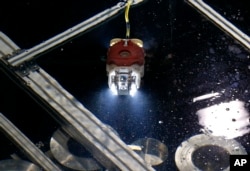Authorities in Japan are trying to decide what to do with the hundreds of thousands of metric tons of contaminated water being stored at the crippled Fukushima Daiichi nuclear plant, which went into meltdown following a 2011 earthquake and tsunami.
It is estimated the huge water storage tanks surrounding the site contain more than 750,000 tons of water contaminated with tritium, considered one of the less harmful radioactive isotopes.
Watch: Japan Considers Release of Fukushima Tritium-Contaminated Water Into Pacific
Local media reported last month that plant owner TEPCO planned to release the water into the Pacific Ocean, prompting an outcry from environmental groups and local fishermen. The general manager of TEPCO’s nuclear division, Takahiro Kimoto, says the company has yet to make a decision.
“One option is to release the tritium-contaminated water into the ocean. However, there are other options such as vaporizing it, but we have not decided yet which option to take to dispose of the water. Since there may be an influence on the environment, and because there have been harmful rumors about what effects it may have on people and the environment, we are still consulting with various stakeholders before finally deciding on the solution,” Kimoto told VOA in an interview.
Tritium releases
TEPCO points out all nuclear power plants around the world release tritium into the environment.
Tritium is considered one of the less dangerous radioactive isotopes, said leading marine radiochemist Ken Buesseler of the Woods Hole Oceanographic Institute in Massachusetts. He has been monitoring the effects of the Fukushima disaster on the Pacific Ocean.
“There are natural sources up in cosmic rays interacting in the atmosphere. And the biggest source by far was the weapons testing in the 1960s. So you’re talking about adding to what’s already there. If it’s all released on one day, that’s a very different scenario for the oceans than if it’s released sequentially over the course of several years.”
A purification system called ALPS is designed to remove other, more harmful isotopes from the contaminated water. Buesseler said more oversight is needed.
“Independently, I want to see for each tank, what are the levels not only of the tritium, which dominates by far the radioactivity, but all those minor elements, cesium, strontium, that are still there to some degree.”
Nuclear fuel removal
Longer-term, Japanese authorities face the task of trying to remove the nuclear fuel. Robots have recorded footage of what appear to be melted fuel rods inside reactor 3, but in other reactors soaring levels of radioactivity have crippled the robots within minutes.
“Around the fall of this year, we are hoping to reveal a big plan on our future policy, and the method we will use to remove this fuel,” said TEPCO’s Kimoto.
The Japanese government estimates the total cleanup cost, including compensation, decommissioning and decontamination, will reach $190 billion in a process likely to take at least 40 years.












